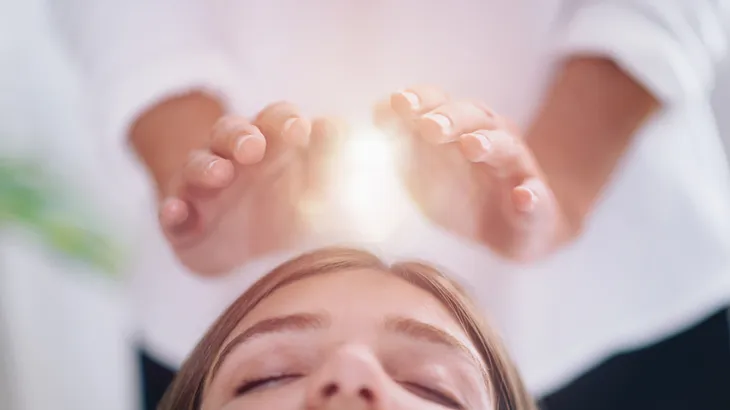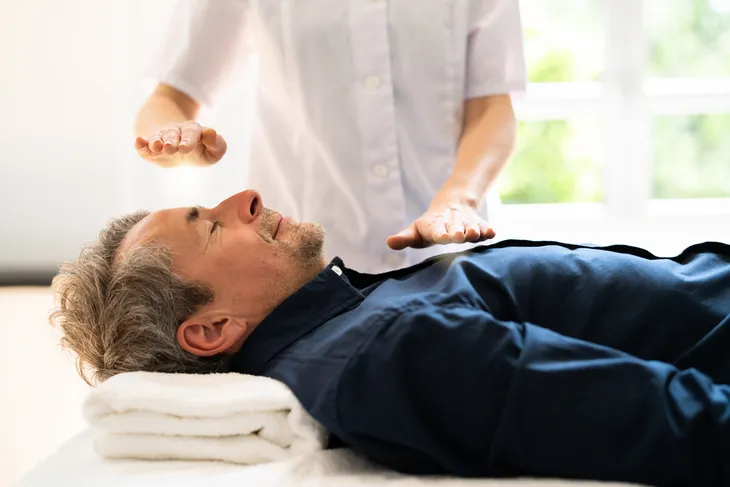- Reiki is an alternative health approach to promote healing, manage symptoms and improve general well-being.
- Reiki is thought to have both physical and mental health benefits such as relief of pain, tension, depression, and anxiety.
- It’s important to note that reiki is not a form of treatment for medical conditions, but many have found it to be helpful in soothing symptoms.
Reiki is a practice that has gained popularity in the world of health and wellness. It’s an energy healing practice that was developed in the early 1900s and is raved about by wellness and health gurus worldwide. While Reiki isn’t a medical treatment, it may have profound benefits in restoring overall well-being and managing symptoms of various disorders. If you’re considering booking a Reiki session, follow along as we break down everything you should know about the healing practice including its purpose, benefits, and how to prepare for your session.
What is Reiki?
Reiki is a Japanese healing technique created by Dr. Mikao Usui in the early 20th century, according to Healthline. While Reiki does not directly heal disease or illness, it is an alternative health approach that may help to manage symptoms and improve general well-being.
During a session, a reiki practitioner will place their hands just above you or directly on you to bring about healing. The goal is for the practitioner to stimulate your body’s natural healing abilities by removing energy blocks and improving the flow of energy around the body, according to Medical News Today.
 Shutterstock/Microgen
Shutterstock/MicrogenPurpose of Reiki
The purpose of reiki is to improve energy flow and remove energy blocks that may contribute to disease or illness. Medical News Today explains that reiki practitioners believe that energy can stagnate in the body in areas of physical injury or emotional pain, which they believe may lead to illness.
There are many physical benefits of a reiki session including the relief of tension, pain, nausea, headache, and more. Reiki may also help to speed healing and improve anxiety, depression, and overall quality of life.
 Shutterstock/Dragon Images
Shutterstock/Dragon ImagesPhysical Benefits of Reiki
Reiki is thought to have both physical and mental benefits for the body. Some physical benefits include the ability to reduce pain. Healthline explains that a 2015 study found that a group of people being treated for cancer noticed lower levels of pain and fatigue while participating in reiki. Another study found that reiki helped significantly reduce pain and anxiety for women following a cesarian delivery.
Additionally, a 2018 study compared the use of reiki to physiotherapy in reducing lower back pain for those with herniated disks. The study found that both treatments were equally effective, but in some cases, reiki provided faster results and was more cost-effective.
 Shutterstock/Microgen
Shutterstock/MicrogenMental Benefits of Reiki
Reiki may also have benefits for mental health. A study in 2016 found that reiki improved depression, anxiety, mood, sleep patterns, and self-confidence, according to Medical News Today. Participants in the study also noted an improved sense of peace, relaxation, and inner calm.
Since reiki is thought to help improve energy flow, it may also help to relieve emotional stress and help with coping for those dealing with difficulties. Medical News Today explains that Reiki is a gentle practice that may help soothe the patient and promote feelings of relaxation in both the body and mind.
 Shutterstock/Microgen
Shutterstock/MicrogenReiki for Medical Conditions
While it’s important to note that reiki is not a form of treatment for medical conditions, many have found it to be helpful in soothing symptoms. Medical News Today explains that some conditions that have found relief from reiki include fatigue, cancer, heart disease, anxiety, depression, chronic pain, infertility, neurodegenerative disease, autism, and Crohn’s disease.
Reiki may be helpful for those living with certain health conditions to provide relief alongside their medical treatment program. For example, someone with cancer may experience relaxation and a boost in their mood by going to see a reiki practitioner while still following their medical cancer treatment program.
 Shutterstock/Andrey_Popov
Shutterstock/Andrey_PopovRisks and Side Effects of Reiki
Reiki is a gentle practice that is non-invasive and thought to be safe. It’s important to note that reiki is not intended to replace any medical treatment plan. Instead, it is intended to be used as a complementary tool to medical care.
Healthline explains that reiki does not have any known harmful side effects, but those with past trauma may find it uncomfortable sitting in a dark room with someone close to them. Forbes Health explains that depending on the nature of the practice, some may feel more emotional or have other intense feelings during or following the session.
 Shutterstock/Albina Gavrilovic
Shutterstock/Albina GavrilovicWhat To Expect From A Reiki Session
Reiki sessions will vary depending on your practitioner, but there are a few common practices that you can expect. A typical reiki session will last between 20 and 90-minutes, according to Healthline. The appointment will likely begin with the practitioner introducing themselves and chatting about your goals and expectations. Be sure to tell your practitioner any specific areas you want to focus on or if you have any injuries or sensitive areas.
The patient will typically lie down on a treatment table or mat during a reiki session. The practitioner may cover you with a blanket and play soft music in the background. There will be little talking during the session, but feel free to speak up during the session to share what you’re experiencing. The Reiki practitioner will move their hands around your body, whether directly or just above your body. You may experience tingling sensations or heat while this happens. Some people also experience visualizations of colors, pictures, or memories.
 Shutterstock/New Africa
Shutterstock/New AfricaCommon Reiki Techniques
Every reiki practitioner may approach the practice a little differently, but there are a few common techniques. The techniques that reiki involves include centering, clearing, beaming, extracting harmful energies, infusing and smoothing, and raking the aura, according to Medical News Today.
Reiki relies on no other tools other than the practitioners themselves, but some Reiki practitioners may opt also use tools to enhance their practice. Some tools that may be used include crystals and chakra healing wands to promote heal and rid the body of negative energy.
 Shutterstock
ShutterstockHow To Prepare for Reiki
Your reiki practitioner may have specific requests for you before your practice, so be sure to inquire about anything you should bring or what you should wear beforehand. Generally, it’s recommended to wear clean, loose-fitting, and comfortable clothing to your reiki session, according to Healthline. You may want to opt for natural fabrics such as cotton, linen, or silk for your practice.
It’s also generally recommended to remove your shoes, jewelry, and glasses before your sessions. Be sure to leave your phone switched off or out of the reiki practice room to ensure there are no distractions during the session.
 Shutterstock/Asmiana
Shutterstock/AsmianaAverage Cost of Reiki Session
A Reiki session can vary in price depending on your location and your practitioner. The cost can also vary depending on the duration of your session. In general, those who are interested in reiki should expect to pay $50-$100 per session. It’s also important to note that reiki is generally not covered by health insurance plans.
One option to consider if reiki is outside of your budget is to check if there is a reiki training center in your area. Healthline explains that often these centers will offer a discounted treatment option for students who are learning the practice.
 Shutterstock/Krakenimages.com
Shutterstock/Krakenimages.comCrystals and Reiki
As mentioned previously, a reiki practitioner should not rely on crystals to do their practice, but they can enhance the session. Healthline explains that crystals are thought to add an extra element of healing and can help to release energy blocks that are emotional, mental, or spiritual.
If crystals are used in your session, they may be placed around or on your body, or you may be asked to hold a crystal. It’s important to note that there is no research to support the use of crystals for healing, but some people claim they have a calming effect. Some examples of common crystals that may be used for healing include rose quartz, amethyst, moonstone, topaz, and tourmaline.
 Shutterstock/ju_see
Shutterstock/ju_seeBecoming a Reiki Practitioner
If you’re looking to become a Reiki practitioner, there are a number of steps you need to take. There is an attunement process to become a reiki master, who is someone attuned to the highest level of reiki. According to Healthline, this process opens your body up so you can transmit healing energy.
Reiki training typically happens in three phases, with each course being at least eight hours long. You must allow time between each phase to practice and develop your skills. There are no health board licenses required to study and practice reiki.
 Shutterstock/Andrey_Popov
Shutterstock/Andrey_Popov


